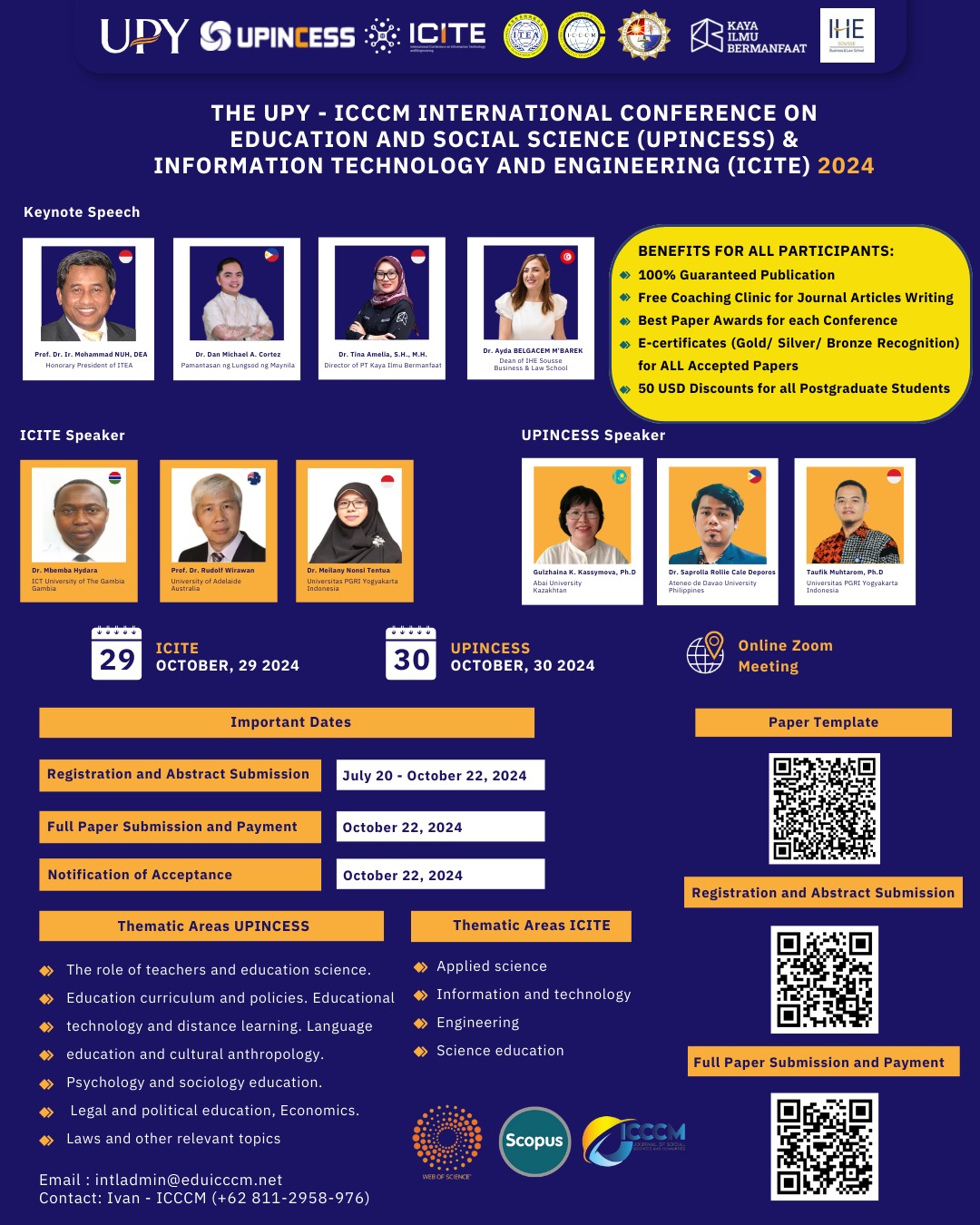The Development of Vikrama Media Based on Local Wisdom in Citizenship Subjects to Improve the Character of Elementary School Students
DOI:
https://doi.org/10.53797/icccmjssh.v1i4.5.2022Keywords:
Vikrama, local wisdom, citizenship, character buildingAbstract
Local wisdom is part of social culture and is inseparable from the language of the community itself. Local wisdom is the knowledge that a particular local community discovers by trying to combine experiences with an understanding of a place's cultural and natural conditions. Indonesia possesses many kinds of local wisdom and plays a strategic role in building social civilization. Local wisdom needs to be instilled in students as early as possible so that they have roles corresponding to the different concepts of Indonesian citizenship through learning media. This study aims to develop an interactive audiovisual medium for citizens based on local wisdom and to test the effectiveness of the medium for fourth graders as if it were the foundation. This research method is related to research and development (R&D). This study used a quasi-experimental design with pre-and post-tests. Data collection used is a questionnaire, interviews, and tests. Validation to the expert obtained valid results with a total score of 91.00 in very good category. The effectiveness test was obtained by calculating the T-test. The results of the T test showed that the pretest had no significant difference in average. Then after that treatment was given and some improvements were made in the process of learning activities, so that the posttest results were less than 0.05, namely the sig value reached 0.000. The conclusion obtained is that there is an average difference between the posttest scores of the experimental group and the control group, but there is no difference in the average pre-test scores for the experimental and control groups. So that the media developed is declared effective on student learning outcomes. The research develops an audiovisual interactive media that can foster character inculcation values in students. After the audiovisual interactive media was developed, it was able to grow the values of character instilling in students through the level of motivation of students getting an average percentage of 96% with a very good category.
Downloads
References
Balaya, A. N., & Zafi, A. A. (2020). Peranan kearifan dalam pembentukan karakter peserta didik. Jurnal Pendidikan Kewarganegaraan, 7(1), 27. https://doi.org/10.32493/jpkn.v7i1.y2020.p27-34
Bria, M. E. (2018). Penguatan semangat nasionalisme di daerah perbatasan. Jurnal Pendidikan Ilmu-Ilmu Sosial, 10(1), 38–43.
Dewinta, A., Nur, F., Sri, S., Imaniar, P., & Tahira, A. Z. (2021). Development of Teaching Material Local Wisdom-Based" Pati" in Elementary School. Asian Pendidikan, 1(2), 59-64. https://doi.org/10.53797/aspen.v1i2.10.2021
Dita, P. P. S., Murtono, ., Utomo, S., & Sekar, D. A. (2021). Implementation of Problem Based Learning (PBL) on Interactive Learning Media. Journal of Technology and Humanities, 2(2), 24-30. https://doi.org/10.53797/jthkkss.v2i2.4.2021
Haryanto, J. T. (2014). Kearifan Lokal Pendukung Kerukunan Beragama pada Komuntias Tengger Malang Jatim. Analisa, 21(2), 201. https://doi.org/10.18784/analisa.v21i02.15.
Kadek, N., Dewi, R., Tastra, I. D. K., & Pudjawan, K. (2016). Pengembangan Video Pembelajaran Berbasis Kearifan Lokal Mata Pelajaran Bahasa Bali Untuk Siswa Kelas III. E-Journal Edutech Universitas Pendidikan Ganesha Jurusan Teknologi Pendidikan, 5(2), 1–10. https://ejournal.undiksha.ac.id/index.php/JEU/article/view/7630/5202
Lestari, I. (2015). Pengembangan Media Bimbingan Dan Konseling Berbasis Islami Untuk Membentuk Karakter Mandiri Anak Usia Dini. Refleksi Edukatika, 5(1). https://doi.org/10.24176/re.v5i1.434.
Lestariningsih, N., & Suardiman, S. P. (2017). Pengembangan Bahan Ajar Tematik-Integratif Berbasis Kearifan Lokal Untuk Meningkatkan Karakter Peduli Dan Tanggung Jawab. Jurnal Pendidikan Karakter, 7(1). https://doi.org/10.21831/jpk.v7i1.15503.
Nuswantoro, D., & Wicaksono, V. D. (2019). Pengembangan Media Video Animasi Powtoon “Hakan” pada Mata Pelajaran PPKn Materi Hak dan Kewajiban Siswa Kelas IV SDN Lidah Kulon IV Surabaya. Jurnal Penelitian Pendidikan Guru Sekolah Dasar, 7(4).
Oktavianti, I., & Ratnasari, Y. (2018). Etnopedagogi Dalam Pembelajaran Di Sekolah Dasar Melalui Media Berbasis Kearifan Lokal. Refleksi Edukatika : Jurnal Ilmiah Kependidikan, 8(2). https://doi.org/10.24176/re.v8i2.2353.
Purwanto, S., Susanto, E., & Pahalawidi, C. (2014). Pendidikan karakter dengan pendekatan sport education dalam perkuliahan di jurusan pendidikan olahraga UNY. Jurnal Pendidikan Karakter, 5(2).
Ridluwan, Achmad, H. M., Murtono, & Chen, Y. J. (2021). Improvement of Learning Interest Through Character Education Reviewed from The Students’ Residence. Asian Pendidikan, 1(2), 37-40. https://doi.org/10.53797/aspen.v1i2.6.2021
Sumarwiyah, Edris Zamroni, & Masturi. (2021). Experiential learning with local wisdom: Prelimenary Study for Improving Analytical Thinking Ability. ANP Journal of Social Science and Humanities , 2(2), 145-150. https://doi.org/10.53797/anp.jssh.v2i2.20.2021
Susanto, K. P. (2013). Hubungan Antara Motivasi Kerja Dengan Organizational Citizenship Behavior (OCB) (Doctoral dissertation, Universitas Muhammadiyah Surakarta).
Suyitno, S. (2016). Pengembangan Multimedia Interaktif Pengukuran Teknik untuk Meningkatkan Hasil Belajar Siswa SMK. Jurnal Pendidikan Teknologi Dan Kejuruan, 23(1), 101. https://doi.org/10.21831/jptk.v23i1.9359.
Downloads
Published
How to Cite
Issue
Section
License
Copyright (c) 2022 Tiara Nugrahartanti, Mohammad Khanzunuddin, Murtono

This work is licensed under a Creative Commons Attribution-NonCommercial-ShareAlike 4.0 International License.




